Some of the most iconic trees in Virginia may come as a surprise to you. Not all are your typical mountain trees, but then again, not all of Virginia is mountain terrain at high altitudes. Plenty of the beautiful nature states are coastal and valley regions. With such a diverse state comes a wide variety of plant, animal, and tree life.
Virginia, the Commonwealth State, has some of the best nature-inspired activities of any state in the country. There is something for just about everyone in the mid-Atlantic state. For starters, there’s the Blue Ridge Parkway, Appalachian Trail, Shenandoah National Park, New River Mountain Trail, tons of bluegrass in the quaint town of Floyd, and epic motorcycle rides on the Back of the Dragon on Route 16. The state truly is overflowing with nature’s very best and it doesn’t stop at the trails. The trees that line those trails are one of the main things that make the trails so amazing.
1. Eastern Redbud (Cercis canadensis)
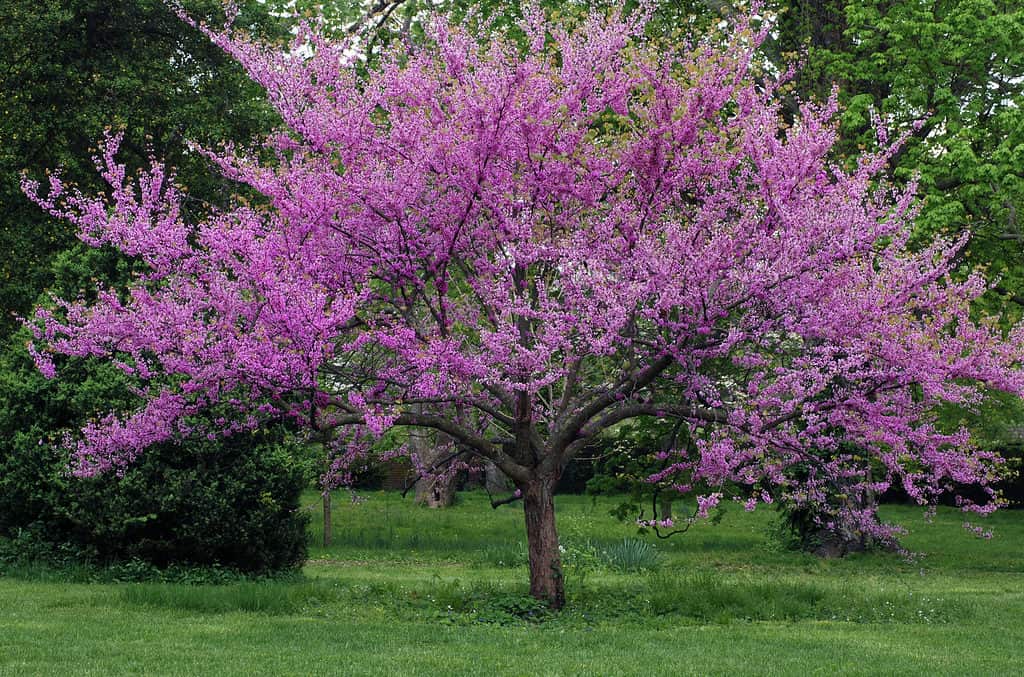
Eastern redbud trees grow beautiful lavender-pink flowers and have heart-shaped leaves.
©Marie C Fields/Shutterstock.com
Size: 20 – 30 feet tall with an equal-sized spread when fully mature.
Known For: A small deciduous tree that has pink flowers in the spring and summer. The redbud doesn’t flower until it is four years old. The seed pods are brownish-black.
2. Honey Locust (Gleditsia triacanthos)
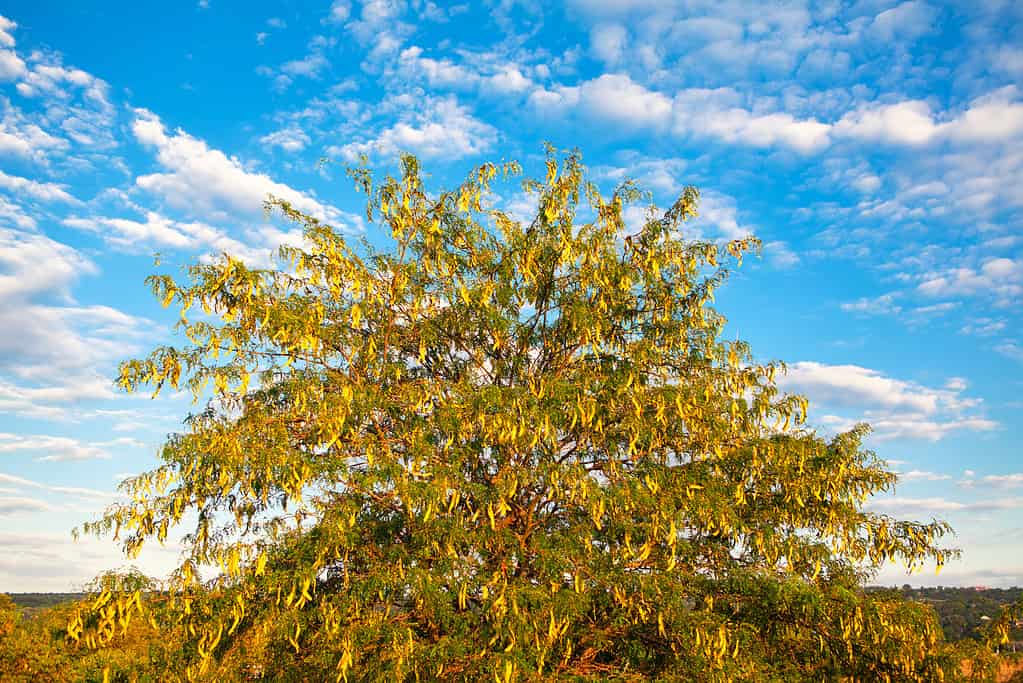
Honey Locust trees provide excellent shade coverage without killing the grass under them.
©RussieseO/ via Getty Images
Size: 30 – 70 feet when mature with an equal-sized spread.
Known For: These are shade trees and do not have thorns. The tree prefers full sun and can grow up to two feet every year. The white and green flowers are very fragrant, and the twisted seed pods provide food for animals. Cherokee in Tennessee used wood to make strong bows and arrows.
3. Longleaf Pine (Pinus palustris)
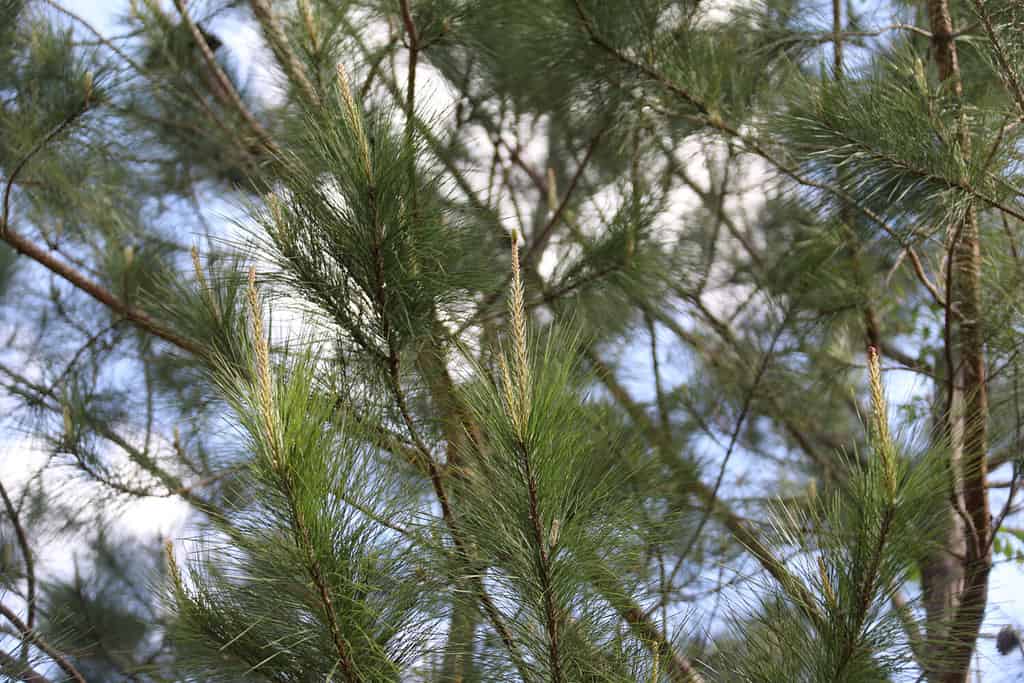
Longleaf pines do not have leaves.
©Natalya Chernyavskaya/Shutterstock.com
Size: 60 – 80 feet tall with a spread that is 30 – 40 feet wide.
Known For: The tree’s dark green needles measure 18 inches long, while the pine cones measure 10 inches. For 5 – 7 years, these trees remain a tuft of pine needles until they develop a solid root system.
4. Loblolly Pine (Pinus taeda)
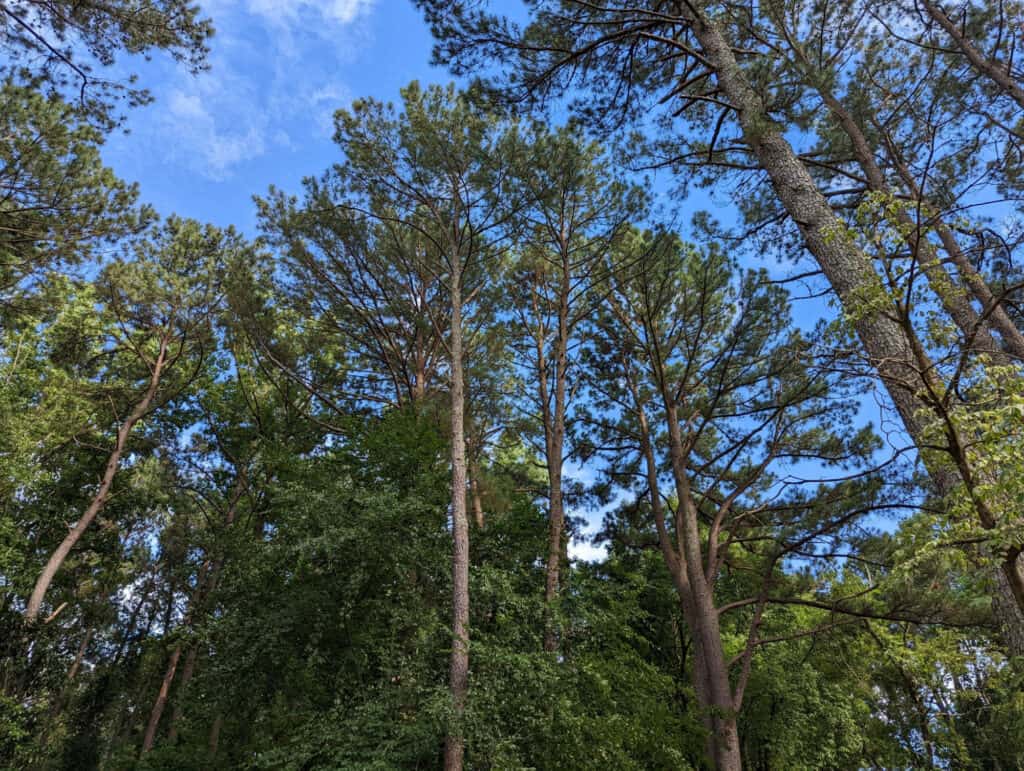
Loblolly pines are the second most common tree in the US.
©Sierra Tango/Shutterstock.com
Size: 60 – 100 feet tall with a spread of 25 – 35 feet wide.
Known For: These tall trees create small reddish-colored pine cones that generally grow in twos. This tree grows 2 feet per year, making a great privacy barrier tree. As the tree ages, the lower branches fall off, creating a good shade tree.
5. Bald Cypress (Taxodium distichum)

Bald cypress trees have knobs or conical knees that grow from the roots to above the ground or water.
©Coastal Girl/Shutterstock.com
Size: 50 – 70 feet tall with a canopy spanning
Known For: This tree most commonly grows in swamps, freshwater marshes, and near rivers or lakes. The reason the tree sticks its conical knees above ground and, many times, out of the water is a mystery. Weirdly, this swamp tree can grow just fine in dry, Texan yards and seems to be able to grow anywhere.
6. Red Spruce (Picea rubens)

The Red Spruce’s pinecones start as red immature cones that turn into large brown bark-like pinecones.
©SBWorldphotography/ via Getty Images
Size: 60 – 115 feet tall with a crown up to 150 feet wide.
Known For: These trees can live to be over 400 years old. Some of the uses for this spruce’s wood include making musical instruments due to its hardness and lack of knots. Long ago, one of the main ingredients for chewing gum was sap from the tree. These trees grow along the Blue Ridge Parkway. Unfortunately, spruce trees are extremely flammable.
7. Bigtooth Aspen (Populus grandidentata)
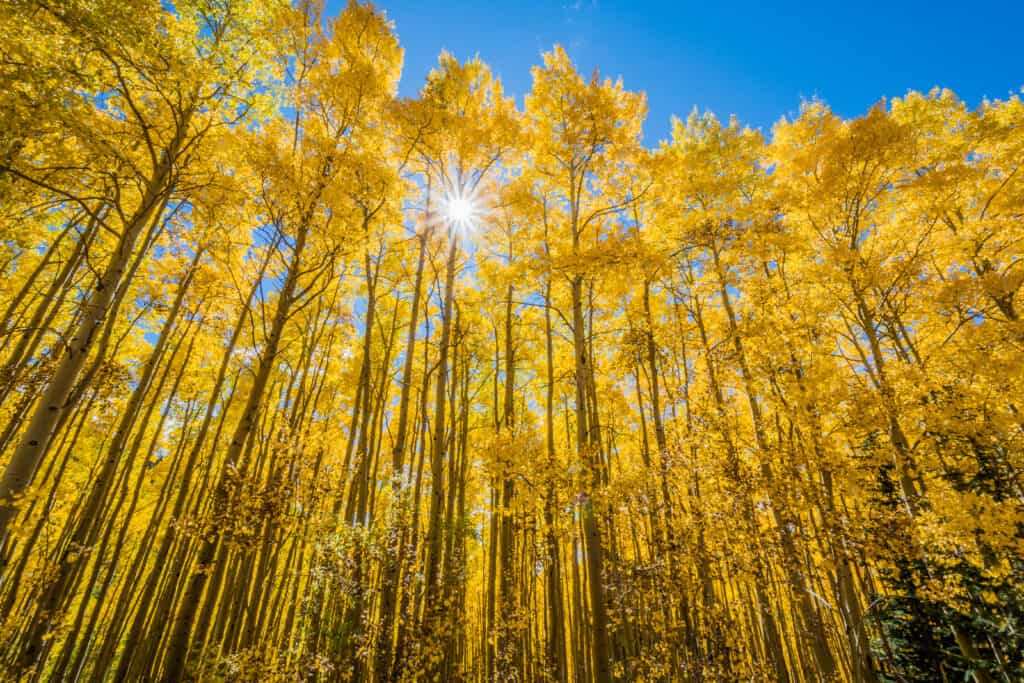
The short-lived Bigtooth aspen is in the willow family.
©iStock.com/Greg Meland
Size: 60 – 75 feet tall with a crown measuring 20 – 30 feet wide.
Known For: This aspen tree lives on average for 50 years but can live up to 100 years. The name comes from the pointy teeth along the edge of the leaves. These full-sun trees are one of the most beautiful in the fall.
8. Black Willow (Salix nigra)

Another short-lived tree, the black willow, only lives to an average of 65 years.
©Sue Burton Photography/Shutterstock.com
Size: Typically 60 – 80 feet tall but can grow to 150 feet in optimal conditions and has a spread of
Known For: Its shallow root system is wonderful for stabilizing soil in erosion control. This tree typically grows near rivers, lakes, and marshes. It does not grow on the very tall mountains found in Virginia.
9. Atlantic White Cedar (Chamaecyparis thyoides)
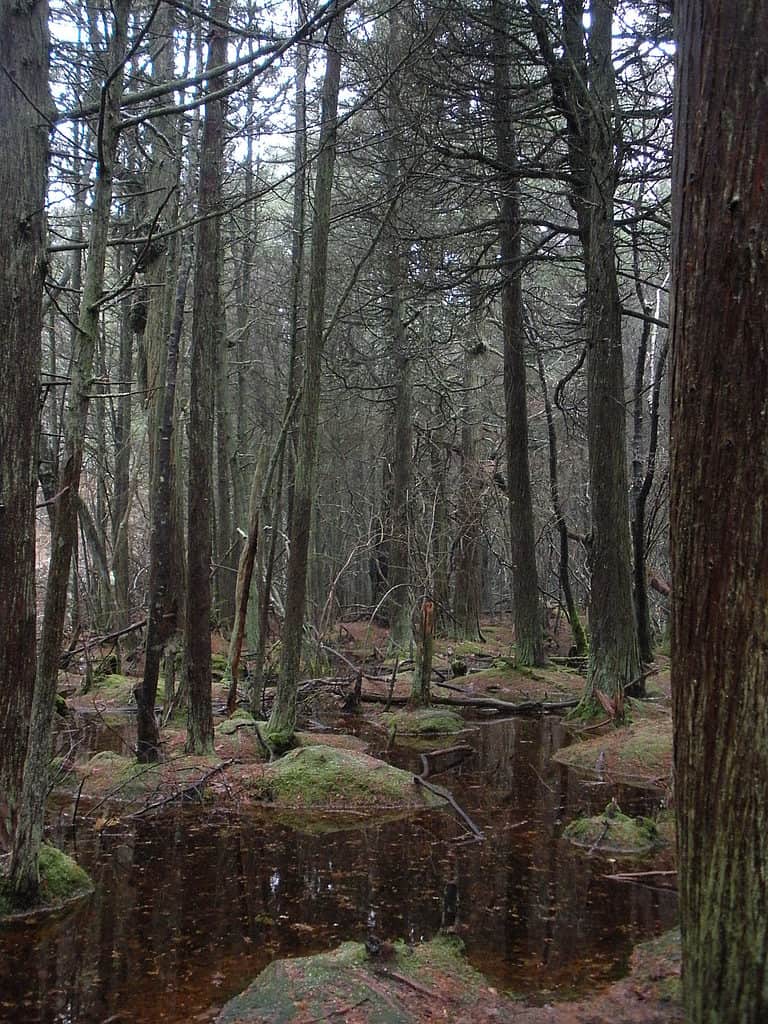
Atlantic white cedar trees prefer wetland habitats, such as swamps, streams, bogs, along rivers, and on the shores of lakes.
©iStock.com/indigojt
Size: 60 – 80 feet tall and has a conical form that spreads 30 – 40 feet wide.
Known For: Cedar trees are known for their aromatic wood, which makes excellent bonfires, firewood for fireplaces, and are used when smoking meat and fish. This tree is amongst the favorite meals for deer in the winter.
10. Sweet Birch (Betula lenta)
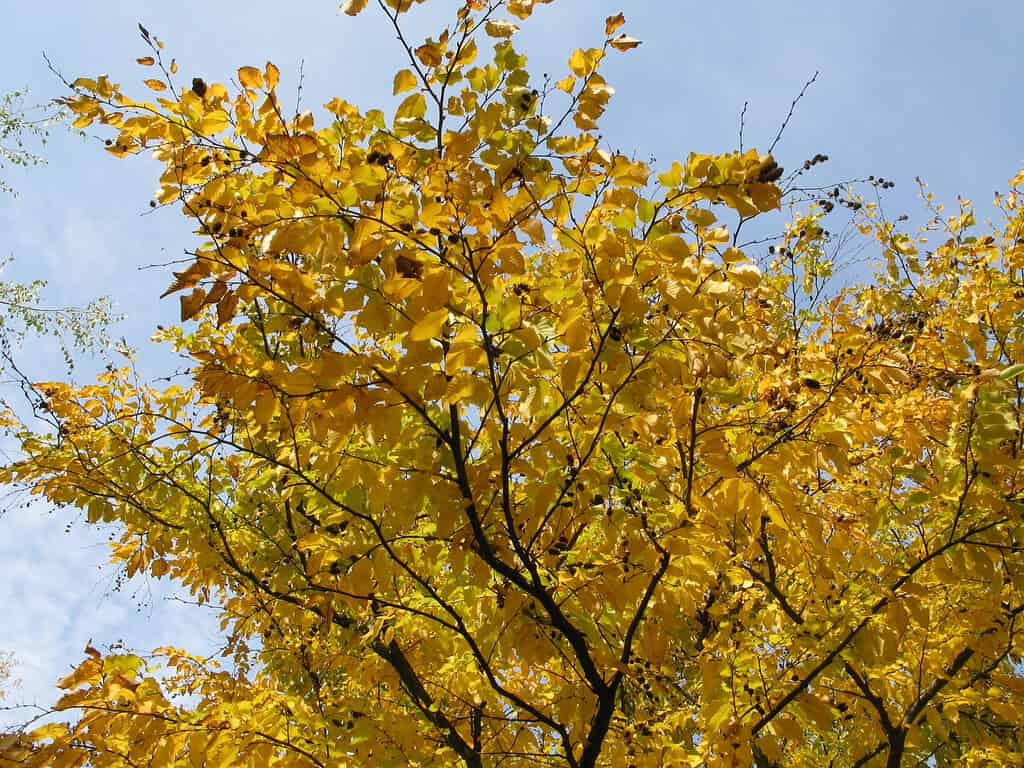
Sweet birch tree (Betula lenta) with yellow fall leaves.
©Adrian Thomale / CC BY-SA 3.0 – License
Size: 60 – 70 feet tall with a crown spanning 35 – 45 feet wide.
Known For: The sweet birch is a pyramid-shaped deciduous tree that grows primarily in the mountain terrain. Wintergreen oil can be made by using this tree. Though, oil from the bark can be toxic. Furniture is also made from the wood of the tree.
11. Black Walnut (Juglans nigra)
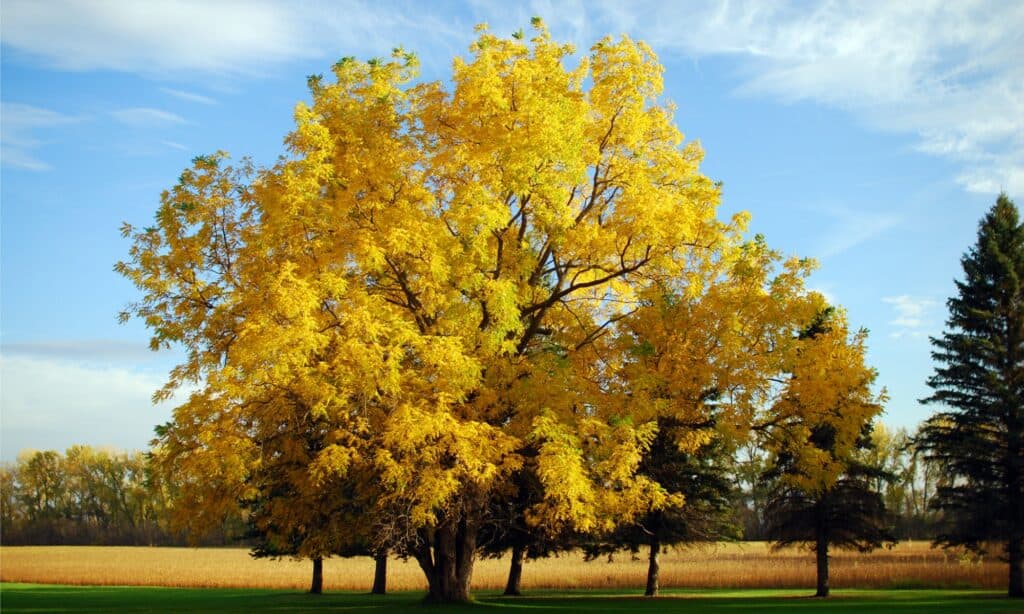
Black walnut trees are magnets for foragers like squirrels. The walnut shell stains their mouths, leaving a brownish-black circle around them.
©iStock.com/jdt01fgo
Size: 50 – 90 feet tall and has a crown of 50 – 75 feet wide.
Known For: These trees typically lose their branches from 3 – 6 feet off the ground and provide good shade cover. Walnut production can take from 6 – 20 years to become fruitful. The fleshy fruit around the actual walnut casing can make stains and dye.
12. Southern Live Oak (Quercus virginiana)

Live oak trees are some of the most beautiful and amazing trees in existence.
©Serge Skiba/Shutterstock.com
Size: Generally around 50 feet tall with massive, sprawling twisted-looking branches that span 50 – 100 feet horizontally.
Known For: The live oak trees are all over the deep south, like Louisiana, and are adorned with beads yearly that hang along with the mystical Spanish moss in New Orleans. Sometimes the huge, sprawling branches are longer than the tree is tall. Also, the branches are spongy and not easily broken.
13. Red Mulberry (Morus rubra)
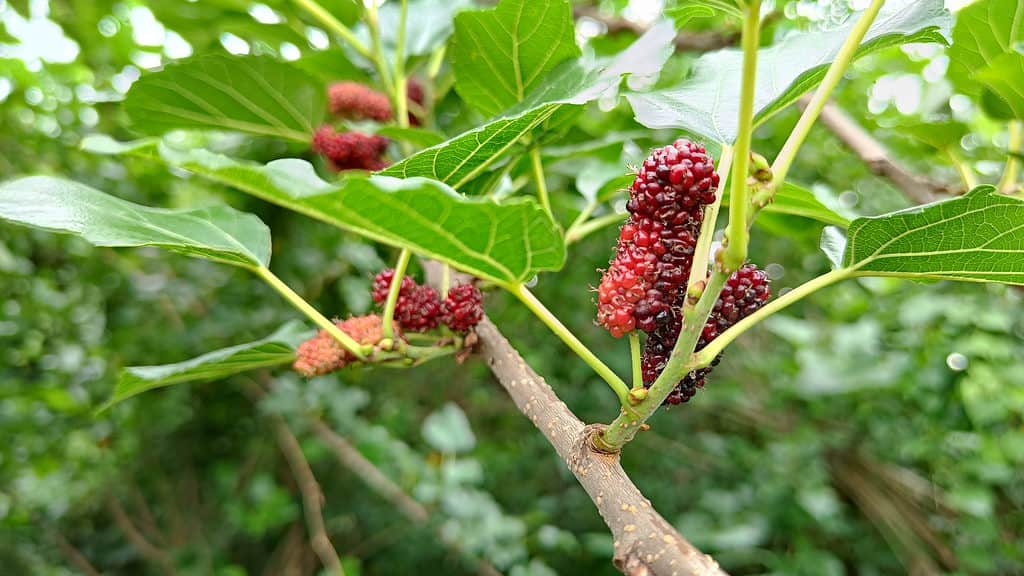
The red mulberry tree has twisted branches and provides good shade cover with its dense foliage.
©iStock.com/Witsanu Patipatamak
Size: 25 – 60 feet tall with a crown of 35 – 40 feet wide.
Known For: The Native Americans used the plant of worming and dysentery. The tree is not very flammable and is a host to the red admiral butterfly caterpillars. The fruit is sweet and can be eaten off the tree.
14. Hackberry (Celtis occidentalis)
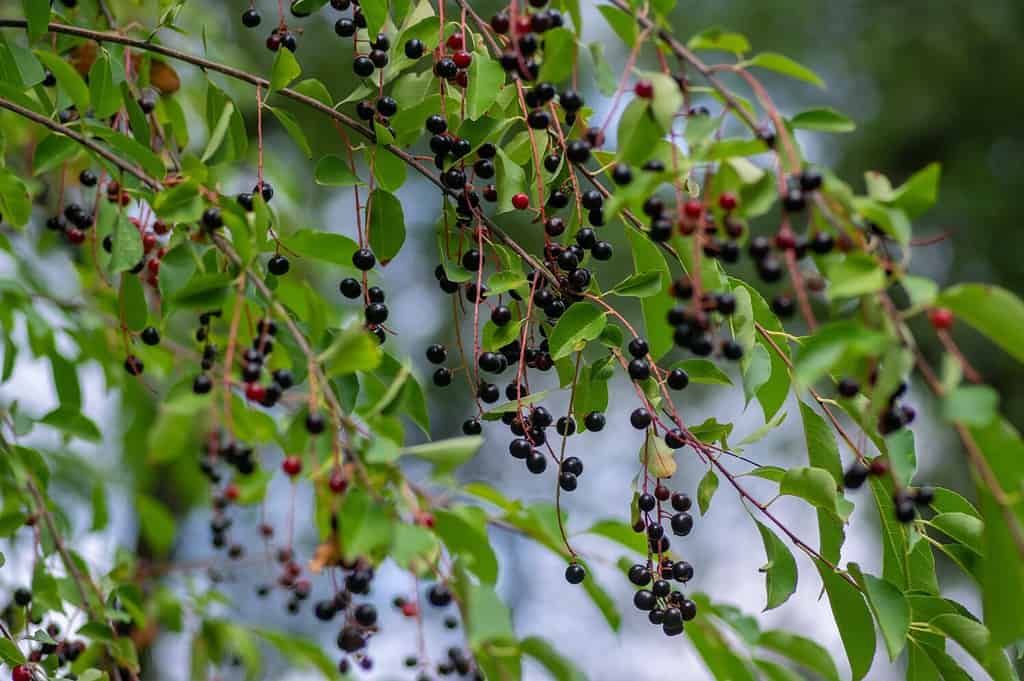
©Iva Vagnerova/Shutterstock.com
Size: 40 – 130 feet tall with a crown of 40 – 60 feet wide.
Known For: Be careful because the Hackberry Leaf Slug (Norape ovina) likes to live on these deciduous trees until they can fly away. The berries can be eaten raw and are slightly sweet. They are sometimes also used to make preserves.
15. Sweetbay Magnolia (Magnolia virginiana)
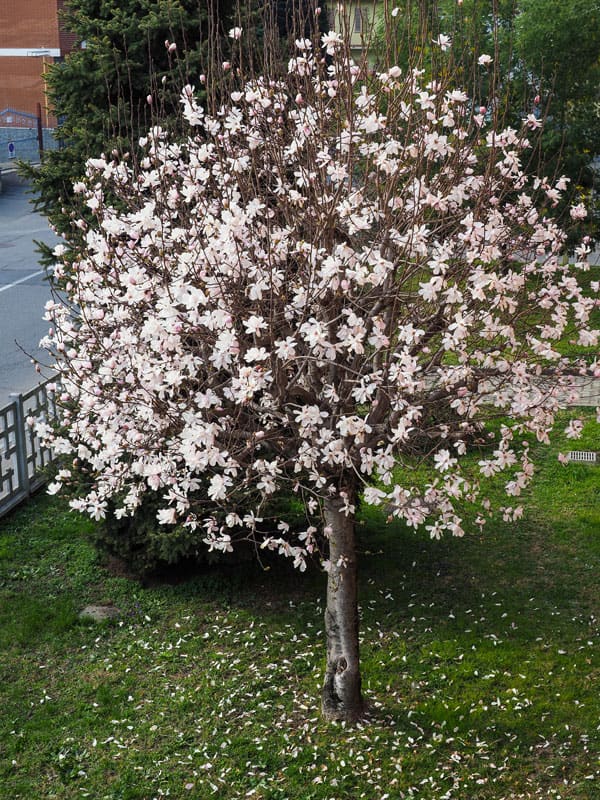
Sweet magnolia trees are sometimes called sweet bay magnolias or swamp magnolias.
©t50/Shutterstock.com
Size: 10 – 35 feet tall with a crown that’s 10 – 35 feet wide.
Known For: The flowers from these trees have a wonderful scent and make great ornamental yard trees. They are very hardy and have low flammability. This is a host plant from swallowtail butterfly caterpillars.
16. Fraser Fir (Abies fraseri)

Fraser firs are what we know as Christmas trees, and many are planted in the VA mountains and valleys to support the holiday yearly.
©Iris_Images/Shutterstock.com
Size: 30 – 55 feet tall with a spread of 10 – 25 feet wide.
Known For: This is a very fragrant tree which has helped make it the first choice among others as a holiday tree. It was named for John Fraser, a Scottish botanist. The tree’s pinecones are not prickly.
17. Chinkapin Oak (Quercus muehlenbergii)
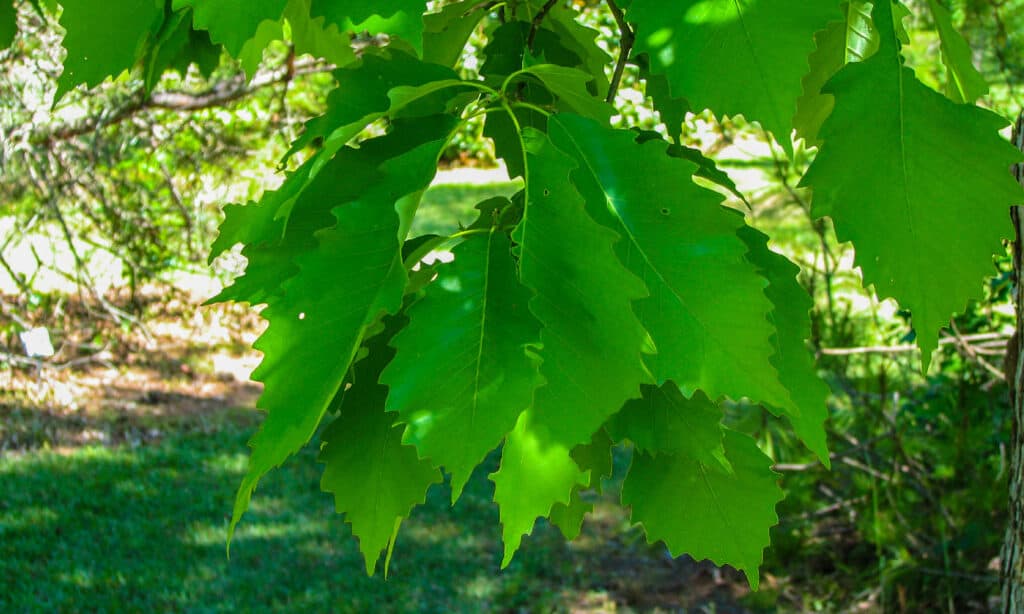
©iStock.com/cws_design
Size: 40 – 60 feet tall and has a crown measuring 50 – 70 feet wide.
Known For: These acorn-bearing trees often line neighborhood roads because of their attractiveness. The acorns draw in a lot of wildlife, and their leaves are food for numerous caterpillars in VA. The acorns are somewhat poisonous to humans and will cause severe stomach issues. They must be first boiled to get rid of the tannins.
18. Red Maple (Acer rubrum)

Red maple trees turn beautiful colors in fall.
©iStock.com/JUN DONG
Size: 40 – 120 feet tall and 30m- 50 feet wide.
Known For: The tree is tapped for its sugary sap that can be used by boiling off the water first. The seeds are located in v-shaped leaves that drop all summer.
19. Flowering Dogwood (Cornus Florida)
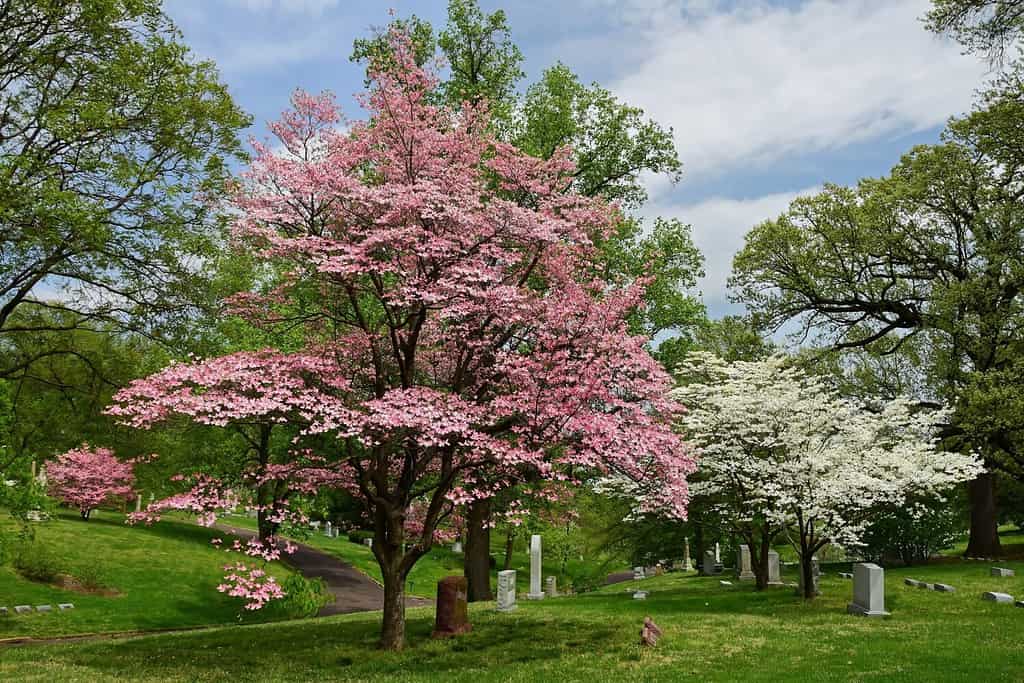
The flowering dogwood is a pretty tree that doesn’t take up much room and is common in suburban yards.
©Nina B/Shutterstock.com
Size: 15 – 25 feet tall, with the crown being 15 – 30 feet wide.
Known For: The wood of the tree is very strong and close-grained. It is used for tool making and textile spools. Its fruits are consumed by a wild variety of wildlife, including birds, bears, and foxes. The leaves are a treat for deer and various butterfly caterpillars.
21. Yellow Poplar (Liriodendron tulipifera)
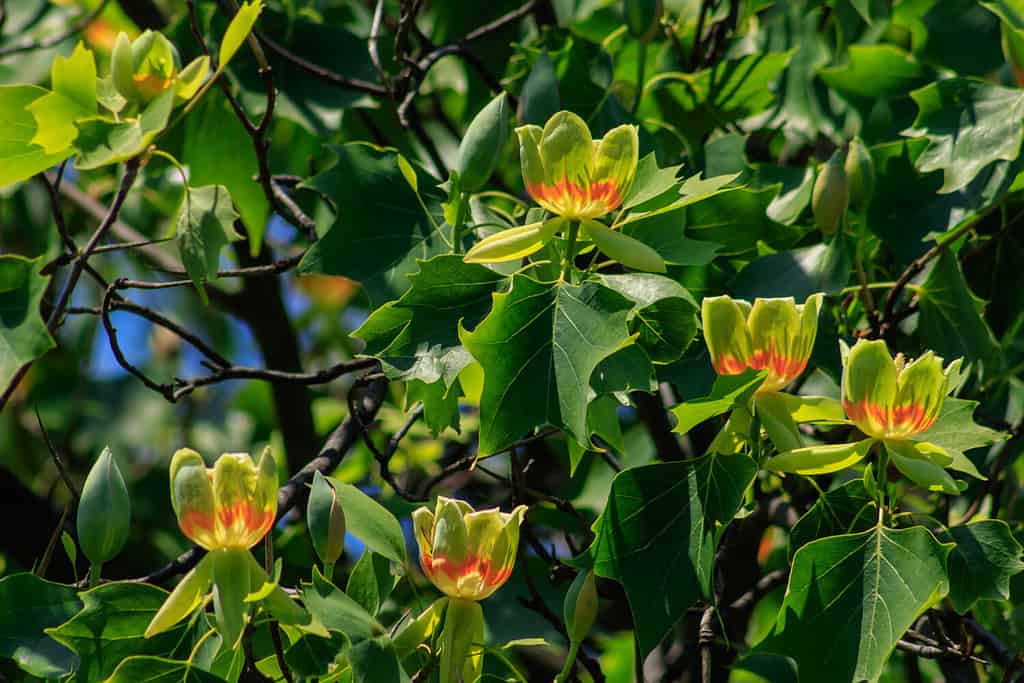
The yellow poplar is sometimes called the tulip tree for the similarities between its blooms and tulips.
©Yanosh Nemesh/Shutterstock.com
Size: 80 – 120 feet tall with a crown measuring 30 – 60 feet wide.
Known For: This pretty deciduous tree is fire-resistant, making it a popular choice for the suburbs. Many types of animals and caterpillars find the tree to be delicious. Pollinators are also big fans of the flowers on the tree. The leaves turn bright yellow in the fall.
22. Water Oak (Quercus nigra)
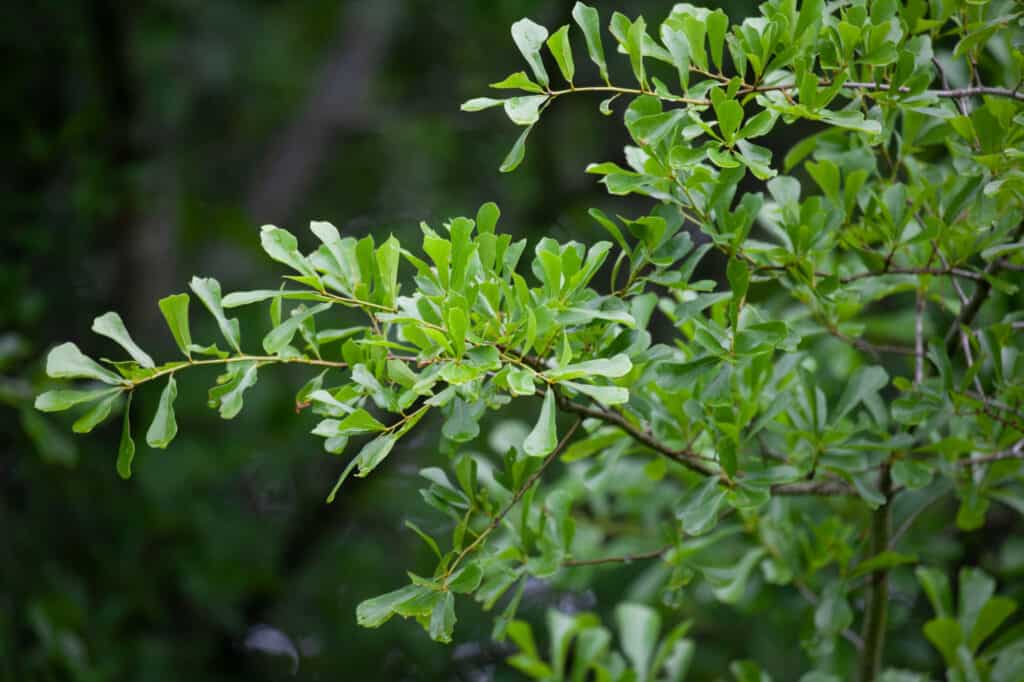
Thriving in wetland regions, the water oak is a fast-growing deciduous tree that has a short lifespan.
©Melinda Fawver/Shutterstock.com
Size: 50 – 80 feet tall and has a crown measuring 50 – 70 feet wide.
Known For: The lifespan of the water oak is only 35 – 50 years, which is sometimes how long it takes for other types of trees to mature. The oak has small black acorns that attract many types of animals. The acorns contain tannins, quercitrin, and quercetin. If eaten by a human, they must be boiled first to avoid severe stomach upset.
23. Slippery Elm (Ulmus rubra)

The slippery elm has many medicinal uses and can live for 200 years.
©ManeeshUpadhyay/Shutterstock.com
Size: 40 – 70 feet tall and has a crown that’s 30 – 50 feet wide.
Known For: This is not a mountain tree since it does poorly above 1800 feet. Slippery elm is used in cough drops. Native Americans used the bark to quench their thirst. In the fall, the leaves become a dull yellow.
24. Virginia Pine (Pinus virginiana)

Belonging to the yellow pine subgenus, Virginia pines have hardwood.
©Nikolay Kurzenko/Shutterstock.com
Size: 15 – 40 feet tall with a crown width of 10 – 30 feet.
Known For: The tree’s leaves support imperial moth larva, and its seeds attract birds. These trees tend to grow in groups and generally do not grow along with other types of trees. Also, the needles are grouped in pairs.
25. Sugar Maple (Acer saccharum)
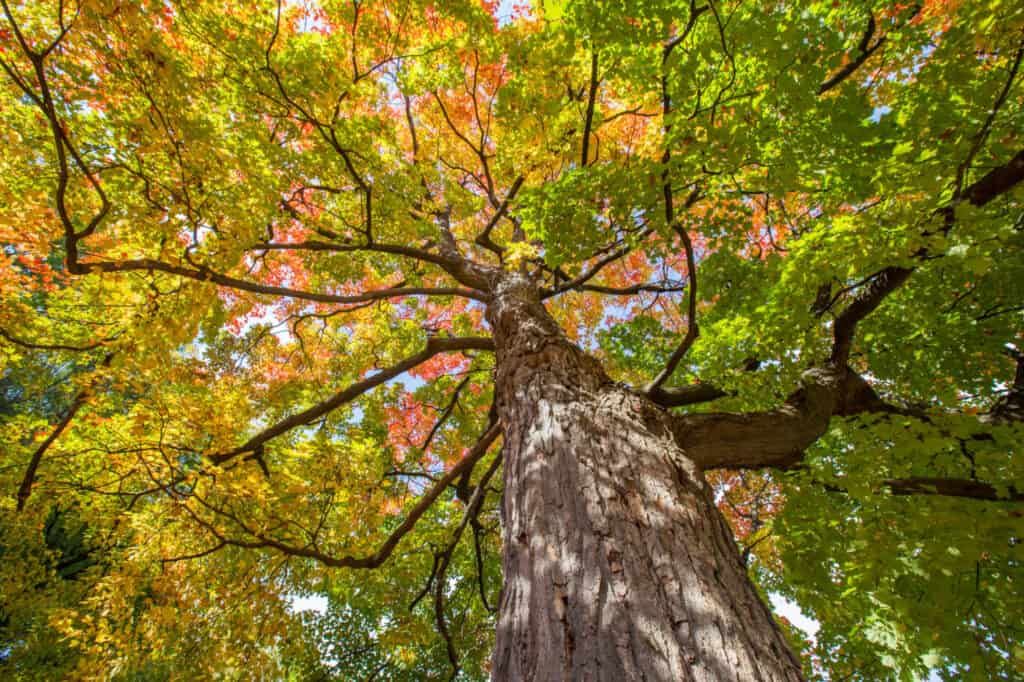
Considered one of the tallest maple tree varieties, sugar maples prefer a colder climate.
©Mircea Costina/Shutterstock.com
Size: 40 – 120 feet tall with a crown that’s 30 – 60 feet wide.
Known For: These trees tend to grow in cooler temperatures in higher elevations. The late winter collection of the tree’s sap is important because it’s one of the main types of sap that creates maple syrup. Native Americans used the sap from this tree to make sodas, candy, and beer. The tree’s wood is an ingredient in making many things, such as flooring, shelves, furniture, and more.
26. American Sweetgum (Liquidambar styraciflua)

American sweetgum (Liquidambar styraciflua) trees turn bright orange and red during the fall.
©iStock.com/sundry photography
Size: 60 – 100 feet tall with a spread that’s 40 – 50 feet wide.
Known For: The prickly balls that fall from these trees can be a bit of a nuisance. The gum from under the bark is an ingredient when making chewing gum, flavoring, perfumes, and some holistic medicines. The wood from the tree is second to oaks as used for cabinetry, plywood, pulpboard, and even boxes.
27. Eastern Hemlock (Tsuga canadensis)
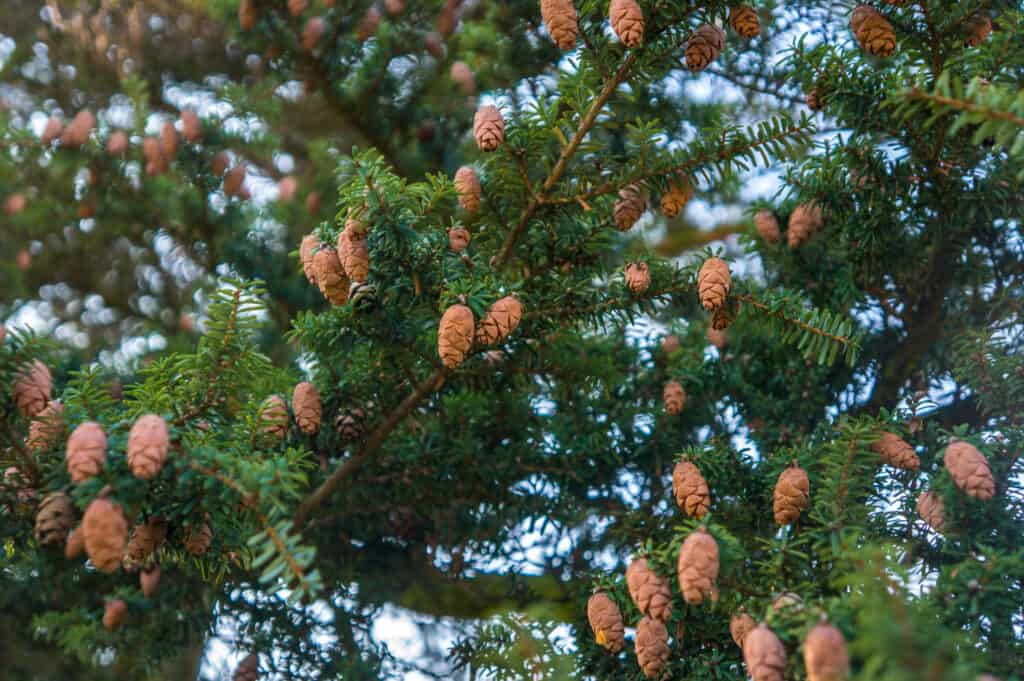
Hemlock trees can endure heavy snowfall and even ice storms
©iStock.com/Sara Lissaker
Size: 40 – 70 feet tall with a crown width spanning 25 – 35 feet.
Known For: Their strange, flat pine needles and vitamin C-rich leaves. The Hemlock has a cone shape with drooping branches and tiny pinecones. These trees provide shelter for rabbits and other small animals.
28. White Ash (Fraxinus Americana)
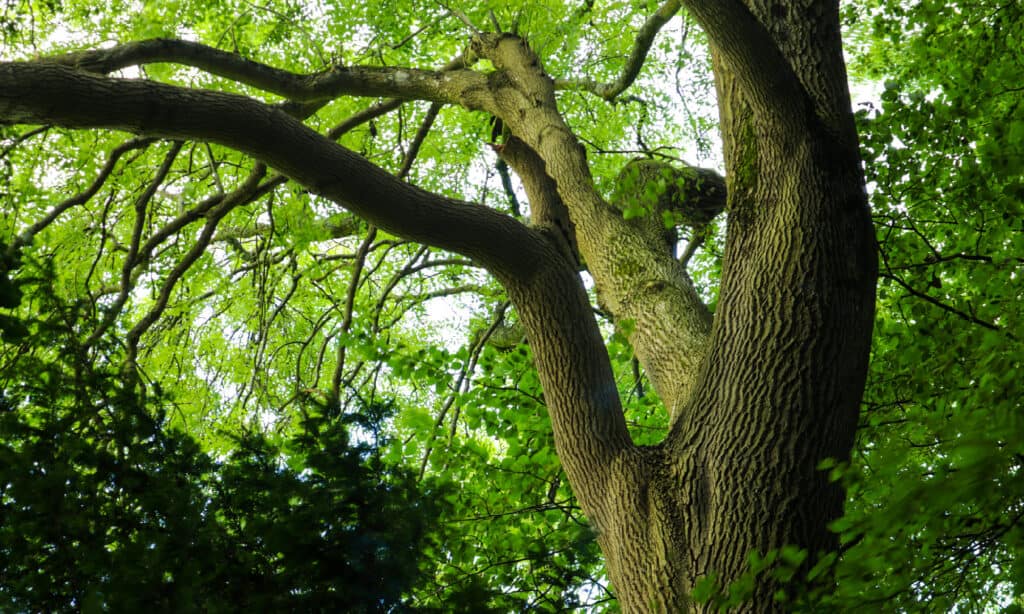
White ash wood was used to make the Louisville Slugger baseball bat.
©iStock.com/Alex Montacute
Size: 60 – 120 feet tall, and the crown is 50 – 75 feet wide.
Known For: These trees do not tolerate salt in the air and do not grow near the coast. They are deciduous trees that grow inland and do well in the mountains. They tend to grow about swamp chestnuts, loblolly pines, sweet gum trees, and others. The juice from the leaves can be used to aid itching from mosquito bites.
29. Shagbark Hickory (Carya ovata)

Shagbark hickory trees can be messy in October when they drop their nuts.
©iStock.com/Ethan R.
Size: 70 – 90 feet tall with a width at the crown of 50 – 70 feet.
Known For: As the tree ages, the bark begins to peel away slightly in 1 – 3 foot strips all over the tree, giving it a shaggy appearance. The tree drops nuts that start as green when immature and change to brown and split open when they mature. The nut inside the shell is sweet and tasty. This is also a wood used for fuel, furniture, and smoking meat.
30. River Birch (Betula nigra)

Also known as black birches, river birch trees thrive in wet conditions.
©Gerry Bishop/Shutterstock.com
Size: 30 – 70 feet tall with a crown measuring 40 – 60 feet wide.
Known For: This is the only birch tree that does well at lower elevations in the south. These trees have bark that flakes off in thin sheets and are similar to paper. The sap can be fermented to make birch beer. The wood is used to make prosthetics, cheap furniture, and basket hoops.
31. Blackjack Oak (Quercus marilandica)

Acorns from the Blackjack oak are an important food source for mammals such as fox squirrels and birds because they are high in fat content.
©Sandyjim/Shutterstock.com
Size: 30 – 50 feet and the crown has a width of 20 – 40 feet
Known For: The acorns will make humans have severe stomach symptoms and they should not be consumed unless boiled. The acorns attract many types of wildlife. This is a tree that will grow where the soil is poor and other trees will not.
32. Sassafras (Sassafras albidum)
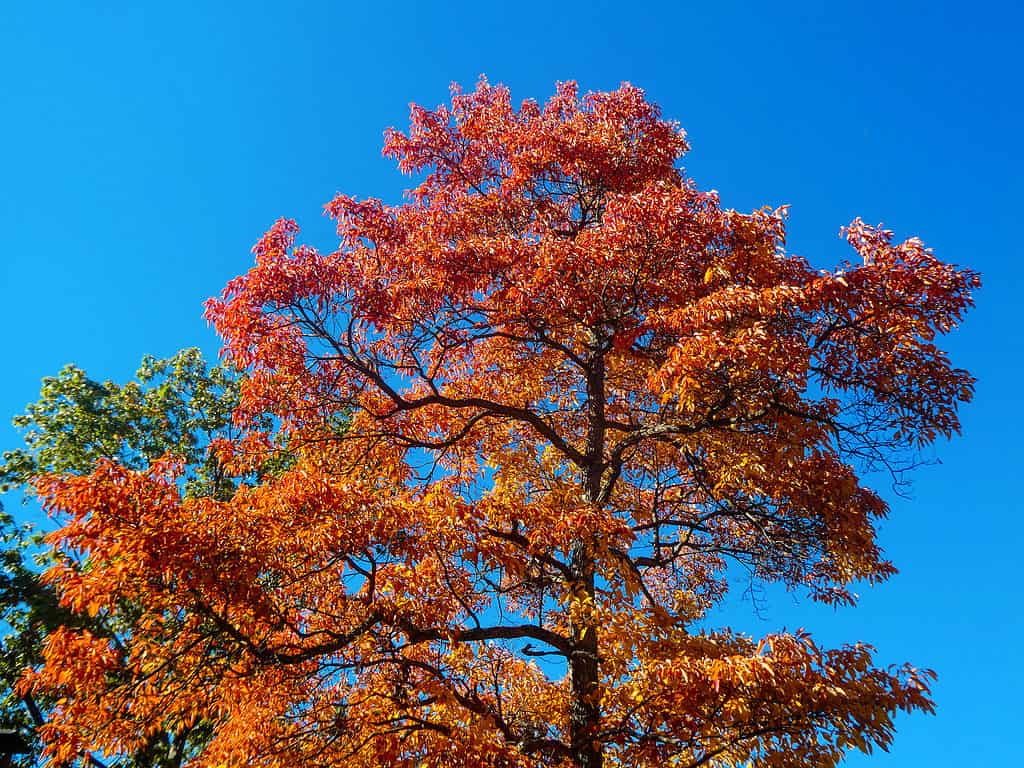
Humans have found a use for all parts of the Sassafras albidum plants, including its leaves, stems, bark, roots, wood, flowers, and fruit.
©ForestSeasons/Shutterstock.com
Size: 30 – 60 feet tall and has a spread that’s 25 – 40 feet wide.
Known For: The sassafras tree has been human uses, such as; filé powder from dried leaves, which is added to gumbo for thickening of the broth, drinks made from the roots, and root beer was once flavored using the bark from the roots.
33. American Persimmon (Diospyros virginiana)

Persimmon trees (Diospyros virginiana) offer shelter and a source of food for many types of butterfly and moth larvae.
©iStock.com/cbglp2
Size: 30 – 80 feet tall and 20 – 25 feet wide at the crown.
Known For: Persimmons make a great food source for birds and many mammals. When the fruit is ripe, it is very sweet. The square-sectioned bark on the tree is sometimes called alligator bark for its appearance. These trees have pretty yellow, orange, or red colors in the fall. Larva from the Hickory Horndevil and the Luna Moth use this as their host tree.
34. Pawpaws (Asimina)
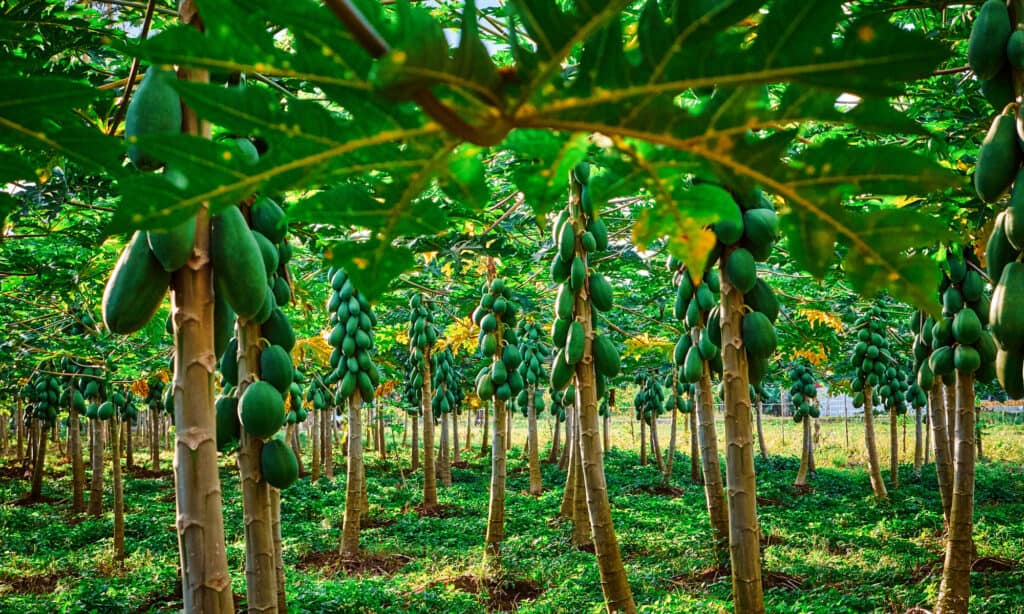
Pawpaw trees stay small throughout their lives and are similar to papaya trees.
©iStock.com/julien manigand
Size: 15 – 30 feet tall and 15 – 30 feet wide at the crown.
Known For: The fruit of the pawpaw tree is sweet and very nutritious, but they are only available from August to October. Plenty of animals and insects eat the leaves and fruit of the tree, making it important to the ecosystem. The zebra swallowtail larva and butterfly both enjoy the essence of the pawpaw tree. Humans need to use caution when touching the fruit because it can cause hives and irritation. The seeds and skin of the fruit can also cause digestional upset.
FAQ
Q: What is the most popular tree in Virginia?
A: The loblolly pine and the yellow poplar
Q: What is the oldest tree in Virginia?
A: The oldest tree is the water tupelo in Greenville County at 600 years old. The tree is also the American Forests National Champion.
Q: What are the biggest trees in Virginia?
A: A water tupelo tree that is 474 inches in circumference. An American sycamore that is 137 feet high, which is as tall as a 14-story building.
The photo featured at the top of this post is © Yanosh Nemesh/Shutterstock.com
Thank you for reading! Have some feedback for us? Contact the AZ Animals editorial team.







